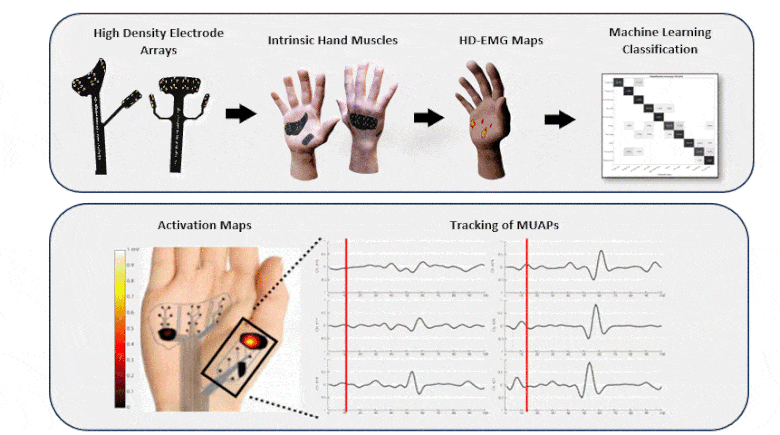
Dexterous hand motion is critical for object manipulation. In normal hand motion, intrinsic hand muscles balance the action of the extrinsic muscles in the forearm to create fluid movements that allow individuals to grasp and hold objects. A set of muscle-specific, flexible, high-density electromyography (HD-EMG) electrode arrays were designed and applied to record myoelectric activity, allowing the analysis of 10 intrinsic hand muscles. This is of special interest in applications aimed at improving the understanding of underlying physiology to mimic dexterous hand motions in robotic devices during the performance of everyday tasks. The novel electrode arrays were designed to overcome constraints from existing specific-purpose electrodes for electrophysiological recordings.
The design considered key aspects like electrode size, spacing and their distribution to account for the specific anatomical characteristics of intrinsic hand muscles. The flexible HD-EMG electrode arrays were applied to train cubic support vector machine (SVM) models to validate their efficacy in classifying hand motions. During experimental validation, the propagation of motor unit action potentials (MUAPs) along the muscle fibers was recorded and conduction velocities were computed. Spatio-temporal amplitude maps allowed the identification of different regions of EMG activity while performing hand motions.
Results demonstrated the electrode array was able to reliably record intrinsic hand HD-EMG and could be used to reliably classify hand movement. The accuracy was directly proportional to the number of EMG electrodes considered for training and validation, dropping from 92±2% with 41 electrode pairs down to 74±4% when only 5 pairs of channels were used demonstrating the advantage of HD-EMG over traditional EMG techniques.
Based on the performance of the proposed electrode arrays, we anticipate the use of these EMG electrodes on the hand could improve electrophysiological research in studies. They could be used along EMG decomposition techniques to assess motor unit activity and in applications involving the analysis of dexterous hand motions.





